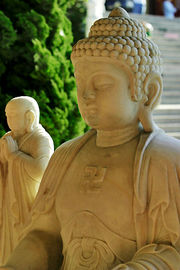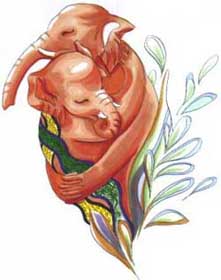Esoteric Buddhism

I decided to put a link here to urbansurvival.com,
so that people will learn that the Buddha's teaching (Dharmic
principles) can also be applied to economy. George Ure says on
his website: Since 1996, this site has expressed
the view that traditional constant-expansion corporate business models
would all collapse some day and that we'd eventually be forced to move
toward green (sustainable) business models - the new economics of responsible
capitalism - or perish. What we all now hear about the problems
with Euro is nothing else but an expanding disease of the ego that refuses
treatment by the Dharmic principles.
Buddhism, contrary
to Hinduism, is a very homogenous path
to liberation - the Buddha's Four
Noble Truths clearly define it. Much of the Buddha's teaching
is related to human "suffering", but the word "dukkha"
(can be roughly translated as suffering) is not suffering as we are
familiar with it, but the truth of the presence of suffering in conditioned
existence (dukkha), which means that we condition ourselves by various
expectations, prejudices, myths and we thus suffer as a consequence
of it. The difference between Buddhism and Hinduism is that Buddhists
do not consider Gods so important as Hindus do; for Buddhists only
the PATH to liberation
or to nirvana is relevant - Buddha
described it very well. Buddhism has two basic schools - Pali
Canon Theravada, also called the Southern
School (Sri Lanka, Indonesia...) and Mahayana
- the Northern School (Tibet, China...).
These two schools have their subschools.
I received an e-mail from India and please think
about it: I would like to say that your website
on Shambhala is terrific! Most Hindu and Buddhist philosophy originated
from there. Thanks again for the site!
Shingon
Shingon is an
esoteric school of Buddhism which
a mysterious monk named Kukai
started in Japan at about the
end of the first millennium (700-800 AD). This school of Buddhism
in Japan is also known as Mikkyo
(a secret path). Mikkyo originated in India and its practice
(beliefs and rituals) is very similar to Ganapatyas
(secret worshippers of Lord Ganesh who
consider Ganesh, contrary to mainstream vaishnavists or shaivists,
the Supreme God of the universe). Ganapatyas
still exist in India, but they are not documented very well, as their
practice is secret like that of Shingon. Most information from both
teachings has never come out to the public.  Shingon
is typical with rituals, magic, with invoking
Gods, etc., which you may also notice, for example, in
the presence of quite unusual statues of Kantingen
(two Ganeshas,
a female and male form of the elephant God making love),
or Kankiten (such a statue is
in Ho-kai-ji Temple in Japan) - the same
deity as Lord Ganesh, but priests
in Japan hold it from the public eyes and keep it in great respect.
Shingon
is typical with rituals, magic, with invoking
Gods, etc., which you may also notice, for example, in
the presence of quite unusual statues of Kantingen
(two Ganeshas,
a female and male form of the elephant God making love),
or Kankiten (such a statue is
in Ho-kai-ji Temple in Japan) - the same
deity as Lord Ganesh, but priests
in Japan hold it from the public eyes and keep it in great respect.
Kukai went to China where Hui-Guo, a master
of Buddhism, initiated him to Chen-yen
or Zhenyan, which is Shingon in
Japanese (or Mantrayâna in Sanskrit). Most historians date the
presence of Ganesha in Japan back to times
when this great monk started his Shingon
sect in Japanese Buddhism. The
manner of worshiping Ganesha, Ganabachi, Vinayaka,
or Kangiten holds attributes that make this cult different from
all other Buddhist schools.
Lama Drukpa Kunley
Bhutan has in
its history a great religious teacher -
Lama Drukpa Kunley, who is known throughout Bhutan as
"Divine Fool."
Drukpa Kunley
was born in the 15th century and was
very peculiar as a child. He had allegedly full
memory of his previous incarnations
and later, after experiencing confrontation with his father's death,
he lost all previous beliefs in the establishment of the world and
dedicated himself to a religious life.
He finally became a monk and a mendicant. He wandered throughout the
country and developed great spiritual arts and skills in magic.
He ridiculed the establishment; especially the corrupt
priests. He is known for performing miracles
like Jesus, which helped him
to treat other people morally. He made miracles like turning tiny
quantities of tea into large amounts and instantaneously appearing
at locations far off wherefrom he disappeared.
He made outstanding poetic
statements such as: "I bow to
traders who exchange wisdom for wealth" or, "I
bow to renunciates who gather wealth secretly."
He was also a friend of alcohol and sex, which apparently
indicates that he was a Master of Tantric Buddhism.
Naree Pon
Naree Pons are
female fairies that appeared
to Buddha when he meditated. They
disappeared then and merged with the surrounding vegetation. It seems
that the legend about them in connection to Buddha mirrors a true
story.
Naree Pons, the Thai
flower pod women - elf like creates, appeared on a few
TV channels like Discovery Channel. One Thai man had a dream and found
these strange creatures after he awoke. They are said to be located
at a place called Petchaboon in Thailand, some 500 km from Bangkok.
A video on youtube.com
is here.
Back


